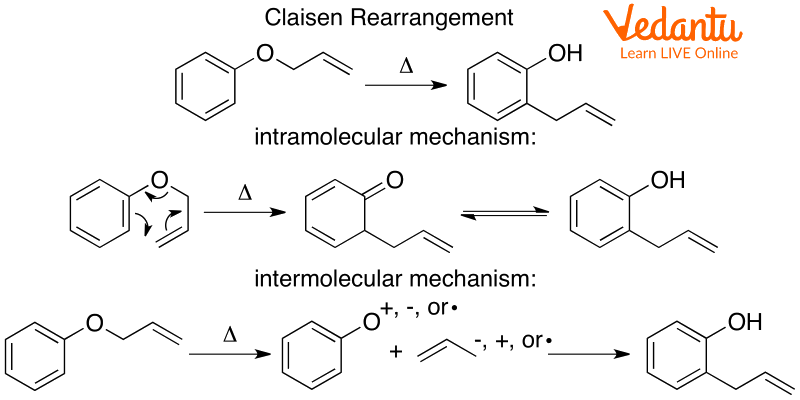




The investigations on the stereochemistry elements of the Claisen reactions deserve special note. The Claisen rearrangement has generated a great deal of investigation due to its value in synthetic activities, especially in the production of natural compounds, and also its use as an instrument to explore the bond configurations of aromatic compounds and its inherent significance as a molecular rearrangement.
The Claisen rearrangement is a systematic, pericyclic, exothermic reaction that involves bond cleavage and rearrangement. Crossover studies rule out the likelihood of the rearrangement taking place through a mechanism involving an intermolecular interaction and are in line with an intramolecular action. It's crucial to remember that Claisen condensation and Claisen rearrangement are two very different phenomena. This article offers a broad outline of the main important subjects pertaining to the Claisen rearrangement.
What is Claisen Rearrangement?
Claisen rearrangement is known as an organic chemical process which provides a potent way to generate carbon-carbon bond formation. When heated or exposed to a Lewis acid, the initiator of this reaction, for example, allyl vinyl ether, transforms into an unsaturated carbonyl molecule.
The mechanism of Claisen rearrangement exhibits significant solvent influences, with polar solvents having a larger tendency to speed up the process. The maximum reaction rates were produced by hydrogen-bonding solvents. The process is more quickly accelerated by polar solvent influences.
Examples of Claisen Rearrangement
The reorganisation of allyl vinyl ether and allyl aryl ether, such as allyl phenyl ether, is accomplished through this Claisen rearrangement. The latter is employed to prepare allyl phenol. These are some of the Claisen rearrangement examples. A Lewis acid or heat can cause the initiator of this Claisen rearrangement mechanism, allyl vinyl ether, to change towards a gamma, delta-unsaturated carbonyl molecule.
Combining C-C π-Bonds
Formally, the Claisen rearrangement can be described as the intramolecular addition of an allylic ether, a sulphide, or an amine to a carbonyl enol (X = O), thiocarbonyl enol (X = S), or an enamine (X = N), accordingly, generating a carbon-carbon σ-bond. The mechanism, which is categorised as a 3, 3-sigmatropic shifting, includes concurrent π-bond movement. It is typically described as coordinated, even though in reality, a variety of processes may be in play. As a result of hetero- and polyhetero-Claisen rearrangements, heteroatoms may occupy additional places and the unsaturation level might well be greater than indicated.

CC 𝝅-Bond
Mechanism of Claisen Rearrangement
A particular kind of sigma tropic rearrangement is the Claisen rearrangement. It is a mechanism in which every bond concurrently forms and breaks. Allyl phenyl ethers can also be used to carry out the Claisen rearrangement mechanism. Allyl phenyl ether is rearranged into its aromatic enol form in Claisen rearrangement. The meta-substitution in this rearrangement has an impact on the regioselectivity. An intermediate is produced via the [3, 3]-sigmatropic rearrangement of the allyl phenyl ether. This intermediate is then subjected to tautomerization, producing a phenol that has an ortho substitution. The allyl phenyl ether Claisen rearrangement is given in below diagram:

Allyl Phenyl Ether Claisen Rearrangement
Variations
Aside from the standard allyl vinyl ether rearrangement, a number of variants have been created that enhance the Claisen rearrangement's synthetic significance in terms of the formation of the parental compounds, the reactive environment, and stereoselectivity. The different types of variations are listed beneath:
Aromatic Claisen rearrangement
Bellus Claisen rearrangement
Eschenmoser–Claisen rearrangement
Ireland–Claisen rearrangement
Johnson–Claisen rearrangement
Kazmaier–Claisen rearrangement
Photo-Claisen rearrangement
Interesting Facts
The Claisen rearrangement mechanism is called after its inventor, German chemist Rainer Ludwig Claisen, who made the discovery in 1912.
It's significant to note that sigmatropic rearrangement was the first [3, 3]- sigmatropic rearrangement process to ever be documented.
In contrast to usual Claisen rearrangements, zwitterionic Claisen rearrangements take place at or beneath room temperature. In milder circumstances, the acyl ammonium ions are especially selective for Z-enolates.
Key Features to Remember
The organic reaction mechanism known as the Claisen rearrangement provides a potent way to generate carbon-carbon bonds.
Claisen rearrangement is an exothermic, pericyclic reaction. When energy is released, the arranging reaction changes and its intermediary transitional phase is cyclic.
If heated or exposed to a Lewis acid, the source of this synthesis, allyl vinyl ether, transforms into a gamma, delta-unsaturated carbonyl molecule.
The conversion occurs intramolecularly, follows a well-organised cyclic transitional phase, and possesses first-order kinetics.






FAQs on Claisen Rearrangement
1. Is Claisen rearrangement reversible?
No, Claisen rearrangement is not reversible. The Claisen rearrangement is largely irreversible because the products are significantly more stable than even the reactants, in contrast to the Cope rearrangement, which is naturally reversible.
2. What are the uses and applications of Claisen rearrangement?
A crucial stage in the production of amino acids like phenylalanine and tyrosine, chorismate is converted into prephenate in nature utilising the Claisen rearrangement. So, the Claisen rearrangement has application in real life.
3. What is the solvent effect observed in Claisen rearrangement?
The solvent effects observed in the Claisen rearrangement, where polar solvents such as ethanol and water have tendency to increase the rate of the reaction to a greater extent. The solvent which forms H-bonding has a higher tendency to increase Claisen rearrangement. For example, “polar solvents such as ethanol and water solvent mixtures give rate constants 10-fold higher than sulfolane”.












